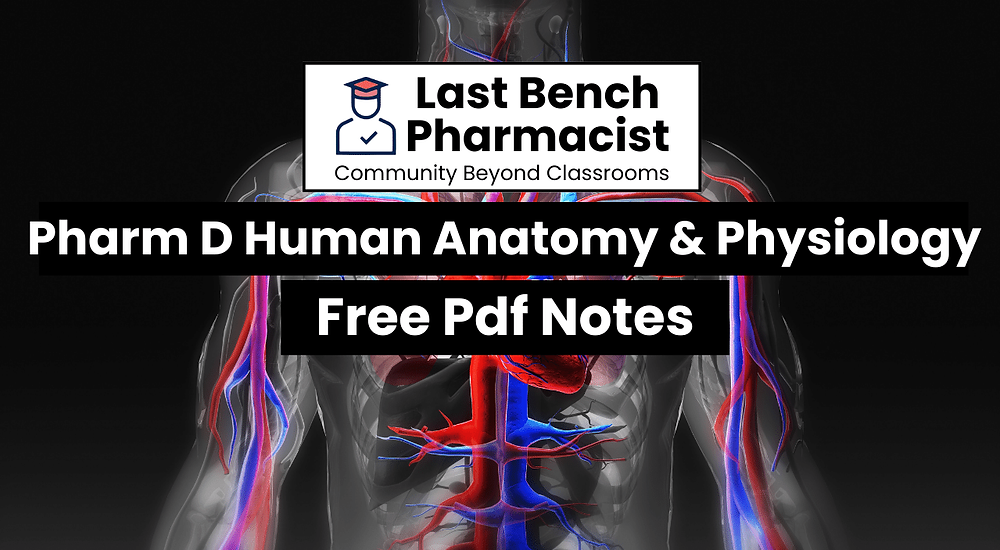



Feeling lost in a sea of confusing anatomical terms and complex physiological processes? Don’t worry, fellow pharmacy student! This post is your life raft. We’ll dive into the world of Pharm D Human Anatomy & Physiology PDF notes, helping you find the best resources to master the intricate workings of the human body. Buckle up and get ready to conquer those exams with confidence!
This course is designed to impart a fundamental knowledge on the structure and functions of the human body. It also helps in understanding both homeostasis mechanisms and homeostatic imbalances of various body systems. Since a medicament, which is produced by pharmacist, is used to correct the deviations in human body, it enhances the understanding of how the drugs act on the various body systems in correcting the disease state of the organs.
Upon completion of the course, the student shall be able to understand:-
Describe the structure (gross and histology) and functions of various organs of the human body;
Describe the various homeostatic mechanisms and the or imbalances of various systems;
Identify the various tissues and organs of the different systems of the human body;
Perform the hematological tests and also record blood pressure, heart rate, pulse and Respiratory volumes;
Appreciate coordinated working pattern of different organs of each system;
Appreciate the interlinked mechanisms in the maintenance of normal functioning (homeostasis) of human body
Scope of anatomy and physiology, basic terminologies used in this subject (Description of the body as such planes and terminologies)
Structure of cell – its components and their functions.
Elementary tissues of the human body: epithelial, connective, Muscular and nervous tissues-their sub-types and characteristics
a) Osseous system – structure, composition and functions of the
b) Classification of joints, Types of movements of joints and disorders of joints (Definitions only)
Haemopoetic System:
a) Composition and functions of blood
b) Haemopoesis and disorders of blood components (definition of disorder)
c) Blood groups
d) Clotting factors and mechanism
e) Platelets and disorders of coagulation
Lymph
a) Lymph and lymphatic system, composition, formation and circulation.
b) Spleen: structure and functions, Disorders
c) Disorders of lymphatic system (definition only)
Cardiovascular system
a) Anatomy and functions of heart
b) Blood vessels and circulation (Pulmonary, coronary and systemic circulation)
c) Electrocardiogram (ECG)
d) Cardiac cycle and heart sounds
e) Blood pressure – its maintenance and regulation
f) Definition of the following disorders Hypertension, Hypotension, Arteriosclerosis, Atherosclerosis, Angina, Myocardial infarction, Congestive heart failure, Cardiac arrhythmias
Respiratory system
a) Anatomy of respiratory organs and functions
b) Mechanism / physiology of respiration and regulation of respiration
c) Transport of respiratory gases
d) Respiratory volumes and capacities, and Definition of: Hypoxia, Asphyxia, Dybarism, Oxygen therapy and resuscitation.
Digestive system
a) Anatomy and physiology of GIT
b) Anatomy and functions of accessory glands of GIT
c) Digestion and absorption
d) Disorders of GIT (definitions only)
Nervous system
a) Definition and classification of nervous system
b) Anatomy, physiology and functional areas of cerebrum
c) Anatomy and physiology of cerebellum
d) Anatomy and physiology of mid brain
e) Thalamus, hypothalamus and Basal Ganglia
f) Spinal card: Structure & reflexes – mono-poly-planter
g) Cranial nerves – names and functions
h) ANS – Anatomy & functions of sympathetic & parasympathetic N.S.
Urinary system
a) Anatomy and physiology of urinary system
b) Formation of urine
c) Renin Angiotensin system – Juxtaglomerular apparatus – acid base Balance
d) Clearance tests and micturition
Endocrine system
a) Pituitary gland
b) Adrenal gland
c) Thyroid and Parathyroid glands
d) Pancreas and gonads
Reproductive system
a) Male and female reproductive system
b) Their hormones – Physiology of menstruation
c) Spermatogenesis & Oogenesis
d) Sex determination (genetic basis)
e) Pregnancy and maintenance and parturition
f) Contraceptive devices
Sense organs
a) Eye
b) Ear
c) Skin
d) Tongue & Nose
Skeletal muscles
a) Histology
b) Physiology of Muscle contraction
c) Physiological properties of skeletal muscle and their disorders (definitions)
Sports physiology
a) Muscles in exercise, Effect of athletic training on muscles and muscle performance
b) Respiration in exercise, CVS in exercise, Body heat in exercise, Body fluids and salts in exercise
c) Drugs and athletics